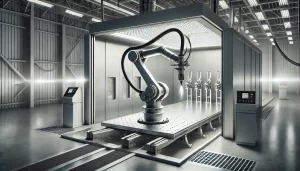When working in a paint booth, maintaining the perfect environment is crucial for achieving a smooth, flawless finish. However, one of the biggest unseen challenges in spray painting is static electricity. If left unchecked, static buildup can cause uneven paint application, excessive overspray, dust attraction, and even pose a fire hazard. Fortunately, with the right approach, static electricity can be controlled effectively to ensure high-quality results and a safe working environment.
Understanding Static Electricity in a Paint Booth
Static electricity is an imbalance of electrical charge on a surface. It occurs when materials come into contact and then separate, causing electrons to transfer from one material to another. In a paint booth, this static buildup is common due to friction between materials such as the surface being painted, the air, and even the painter’s equipment. When static electricity is present, it can either attract unwanted dust particles or cause paint particles to misalign, leading to uneven coatings.
Since spray painting involves fine particles of paint being dispersed in the air, static electricity can have a significant impact. If a surface has too much static charge, it will repel or attract paint inconsistently, causing defects like streaking, blotching, or excessive layering. This not only affects the visual appeal of the final product but can also lead to costly rework.
Practical Ways to Prevent Static Electricity
The key to controlling static electricity in a paint booth is to create a conducive and balanced environment where electrical charges can dissipate safely. Here are some simple yet effective methods to achieve this:
1. Proper Grounding of Equipment and Surfaces
Grounding is the most effective way to neutralize static electricity in a paint booth. All metallic objects, including the paint booth structure, spray guns, and workpieces, should be properly grounded. This allows any static charge to flow safely to the ground, preventing it from interfering with paint application. Using conductive hooks, racks, or fixtures can also help ensure that parts remain grounded during the painting process.
Painters should also be grounded to prevent static buildup on their bodies. Wearing conductive footwear or using anti-static mats can reduce the risk of static transfer when handling spray equipment.
2. Controlling Humidity Levels
Dry air is a major contributor to static electricity. When humidity is too low, materials and surfaces are more likely to build up an electric charge. To combat this, maintaining a relative humidity level of around 50% to 65% inside the paint booth is recommended. This level of moisture helps dissipate static charges naturally and reduces the likelihood of paint defects.
Installing a humidity control system or using misting sprays can help keep humidity at an optimal level, especially in dry climates or during colder months when indoor air tends to be drier.
3. Using Anti-Static Cleaning Methods
Before painting, surfaces should be cleaned using anti-static wipes, solutions, or ionized air guns. Regular tack cloths can sometimes increase static buildup, so using anti-static alternatives helps eliminate residual charges before spraying begins.
Ionized air guns work by neutralizing the static charge on a surface using a stream of charged air particles. These devices are particularly effective for non-metallic or plastic parts that do not conduct electricity well.
4. Choosing the Right Paint and Additives
Certain types of paint, particularly water-based coatings, are less likely to generate static electricity compared to solvent-based paints. If static electricity is a recurring issue, switching to a waterborne paint system can help minimize static-related defects.
Additionally, some anti-static additives can be mixed into paint formulations to reduce static buildup. These additives help paint particles distribute more evenly, leading to a smoother and more consistent finish.
5. Using Conductive Flooring and Work Surfaces
Non-conductive materials such as plastic and rubber tend to accumulate static charges. Using conductive flooring, workbenches, and spray booth surfaces ensures that static electricity dissipates quickly rather than building up over time. Special anti-static flooring materials, grounding grids, or floor mats can be installed to reduce static accumulation in high-risk areas.
6. Implementing Safe Handling Practices
Beyond environmental controls, the way materials and equipment are handled also plays a role in preventing static buildup. Fast movements, excessive rubbing, or dragging objects across surfaces can generate static electricity. Being mindful of handling techniques, such as lifting instead of dragging parts, can help minimize friction-based charge buildup.
Additionally, using anti-static gloves or ensuring that painters do not wear clothing made from synthetic fabrics (which can generate static) can further reduce unwanted electrical charges.
Safety Considerations
While static electricity primarily affects paint quality, it can also pose a serious safety hazard. Since many paints and solvents are flammable, an uncontrolled static discharge can ignite vapors in the booth, leading to fires or explosions. Ensuring proper ventilation, regularly checking grounding connections, and using explosion-proof equipment help mitigate these risks.
Additionally, regular maintenance of the paint booth, including cleaning surfaces and monitoring humidity levels, will go a long way in keeping the working environment safe and productive.
Achieving a Flawless Paint Finish
By implementing these preventive measures, static electricity in a paint booth can be controlled effectively. Proper grounding, humidity control, anti-static cleaning methods, and careful handling all contribute to an optimal painting environment. Not only do these techniques improve the quality of paint application, but they also enhance worker safety and reduce costly rework.
Whether painting small components or large industrial parts, maintaining control over static electricity ensures a smooth, even, and professional finish. With the right approach, your paint booth can operate efficiently, producing high-quality results with minimal disruptions.




